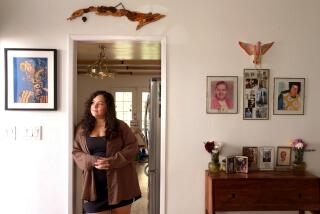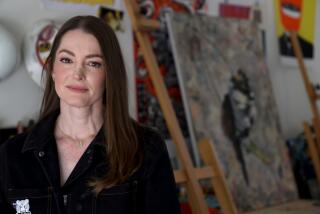FASHION : Specialty Models Put Their Careers in Good Hands
- Share via
Photographers, art directors, account executives and food stylists are crammed around the massive camera anchored in the center of the studio. All of their eyes are riveted on model Don Maderich. Or, more properly, on Maderich’s hands.
Maderich is co-starring--from the wrist down--in a photo-shoot for a restaurant chain. He’s being paid $150 an hour to hold a tortilla in one hand and a fork in the other. Like most aspects of modeling, it’s not as easy as it sounds.
“Roll your pinky in on your left hand,” photographer Dennis Skinner commands. “Now, squeeze the fork a little tighter. Push your fingertips in a little. That’s good, Don. Now move your hand down a little. Now turn this way. Can you turn that way? Now slide in there a little. OK, that’s good.”
“It might make a better hand like this,” Maderich says, repositioning his fingers ever so slightly.
“That’s better,” Skinner admits. Then an art director adds, “The hand with the fork is great. “
Maderich beams with pleasure as he contemplates yet another satisfied client. During the last 15 years, his hands have been featured in thousands of print advertisements and television commercials. He’s typed for Apple Computers, caressed fannies for Ditto Jeans, signed checks for Bank of America, delivered pizza for Godfather’s, poured wine for Gallo, flipped tops for Pepsi, even scratched off winning numbers for Lotto. With all due respect to the Dodger blue-bloods of Chavez Ravine, he’s got two of the best-known mitts in town.
Maderich is one of Los Angeles’ top hand models. Although their names are unknown outside the advertising industry, their work can be seen everywhere--on magazine covers, television, movie posters, billboards, product labels and coupons. They are modeling’s ultimate specialists.
Hand modeling is a sub-specialty of what’s known as parts modeling. Some parts models do legs, others do feet and there’s even an occasional call for eyes or ears. But hands are the most sought-after part. After all, they’re used to sell virtually every product on the market, from cars to credit cards, diapers to diamond rings, lettuce to laundry detergent.
Naturally, different products demand different hands. On the male side, there are large, brawny hands that work best in, say, beer campaigns, and then there are more delicate hands favored for items such as computers.
“I have kind of an upscale hand,” explains hand model Drake Madison. “I do a lot of high-ticket-type items--Citizen watches, champagne and so on. It’s really weird, but I’ve sometimes not gotten a job because my hand was too sophisticated.”
So far as women go, the standard division is between elegant hands with long nails, which are perfect for jewelry and cosmetics, and well-proportioned but less glamorous hands appropriate for household and business products.
And then there’s Denise Feir, one of L.A.’s only unisex hand models. While she stands 4 feet 10 inches tall, her hands are as small as an 8-year-old boy’s or girl’s. Besides playing kids on McDonald’s, Wendy’s and Jack-in-The-Box commercials, her hands have been featured on countless Mattel, Kenner, Hasbro and Coleco spots. “I’ve gone down to (portraying) an infant,” she says, “but that’s pushing it.”
The man widely regarded as the busiest hand model in town--the ubiquitous Bill Karp, who’s featured in virtually all Anheuser- Busch () and Pizza Hut advertising--is more than just another pretty palm. Karp specializes in pouring beers with perfect heads, slicing vegetables in mid-air and generally performing feats of awesome manual dexterity.
“I don’t rehearse or practice,” Karp says. “I guess I just have a God-given knack.”
With the exception of New York City, Los Angeles is probably the largest hand-model market in the country. But despite all the action, only a dozen or so local models derive the bulk of their income from hand work. Rare indeed are the hand models who don’t augment their income with acting or other parts modeling.
Because supply exceeds demand, the competition for hand modeling jobs is fierce, and while the back-stabbing that characterizes fashion modeling is largely absent from the hand game, there’s little love lost between many of the more competitive players.
As model Gene Poe says, punctuating the thought with a grim chuckle, “There are some you wouldn’t mind giving a little shove if they were standing next to a meat grinder.”
Models covet hand modeling jobs primarily because they pay roughly $150 an hour for print ads and $400 per eight-hour day for TV commercials. Although fashion and face modeling are more glamorous, hand modeling can be steadier and more lucrative for the very reason that its biggest stars remain anonymous: One hand looks like another to the general public, which means models can work for competitive clients without any conflicts of interest.
“When IRAs first came out, I think I did every bank in L.A.,” Maderich says. “A lot of people say they built their house with their own hands. I like to say that I bought my house with my own hands.”
But despite the obvious benefits, few hand models actively sought out a career in the field. For example, one-time client agent Michele Slate, whose hands have been featured in more than 2,500 commercials during the last two decades, got her first job because a frantic director desperately needed a woman to lift a product out of a frame for a commercial, and she was available. “When I got finished,” she recalls, “I looked at him and said, ‘People get paid for this?’ ”
Most hand modeling jobs, though, are considerably more difficult. In fact, short of a paper cut, nothing irritates hand models more than the notion--common among outsiders--that their job is so simple that anybody can do it.
They say it demands tremendous muscular control to remain motionless for painfully long periods of time. Hand models also must be resourceful and flexible enough to accommodate the awkward positions required in most shoots.
“A lot of times, you want to put your camera where his head is supposed to be,” photographer Jeff Nadler explains. Adds Jeanette Cook, whose hands have starred in dozens of Kraft spots, “You’re always in a weird position. If people were to walk in (during a shoot), they’d probably say, “Oh, something kinky is going on here.’ ”
Every hand model has a few favorite tales of woe to relate. Slate recalls spending most of a day balanced precariously over a 200-gallon fish tank on 2x4s strung between two ladders on a dish-washing detergent shoot. For Madison, it was holding a violin and bow in the same position for seven hours. “After a while, the blood left my arms, and I started shaking,” he says.
“One day, I had to open, like, 500 cans of dog food,” Poe says. “Another time, for a Midwestern fertilizer company, they hung me upside down in a harness for eight hours. I was supposed to be the hands of God (appearing) over a town.”
Cook’s most absurd assignment was for a Chicago grocery store chain. “They’d tell me, ‘Now fondle the fruit, and make it look realistic,’ ” she says.
The one concern all hand models share is a fear that something will happen to their meal tickets. A tiny cut, a chipped nail, the smallest blister or just about anything else that most people accept as unavoidable are enough to throw hand models out of work. As a result, hand care is their obsession. “It’s a 24-hour job,” Feir says.
Almost without exception, hand models regularly moisturize their hands, manicure their nails, wear gloves when doing dishes or gardening and avoid heavy machinery. Frick puts petroleum jelly and heat mitts on her hands before going to sleep. Karp has gone so far as to insure his hands for $1 million.
The one thing they can’t do, much to the chagrin of their employers, is change the structure of their hands. Cook remembers a photographer who repeatedly complained, “Oh, get rid of those knuckles!” More ridiculous still was Madison’s experience with another photographer. “He told me that the pad of my thumb was too lean, and could I do some exercise to strengthen it.”
He couldn’t, of course. Fortunately, Madison’s hands, like those of his colleagues, are already among the best in the business.






